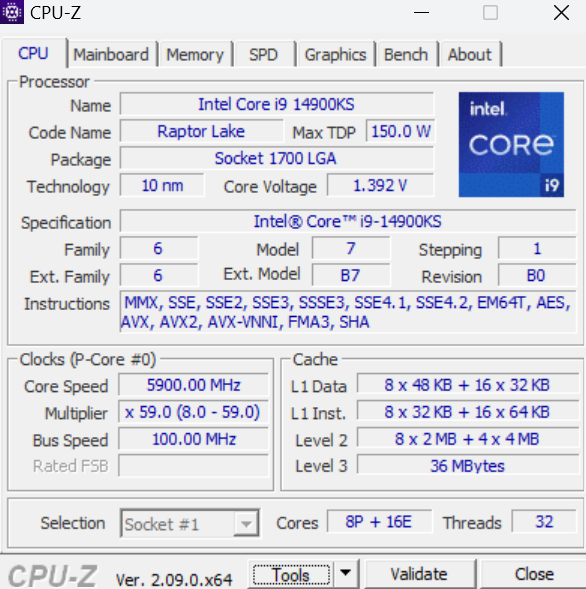Intel has historically introduced “KS” edition CPUs alongside their series of desktop processors, offering enhanced performance over their standard flagship models. The latest Core i9-14900KS, a standout performer in Intel’s 14th Generation Core family, boasts impressive turbo clock speeds up to 6.2 GHz right out of the box. This launch marks an end of an era, as Intel plans to phase out the ‘i’ branding in future desktop chip releases.
The Core i9-14900KS, with its turbo speeds reaching up to 6.2 GHz, claims the title of the world’s fastest desktop CPU regarding out-of-the-box frequencies. Building upon the foundation set by its predecessor, the Core i9-14900, the KS variant benefits from the updated Raptor Lake (RPL-R) architecture, featuring an 8P+16E core design with both base and boost clock speeds elevated by 200 MHz and 100 MHz, respectively, on the P-Cores.
Intel’s intent with the KS series is to push performance boundaries, offering their top Raptor Lake Refresh silicon for those seeking maximum performance. However, consumers should be aware of the power and cooling requirements, with the 6.2 GHz boost clock necessitating upwards of 350 W, posing a significant cooling challenge.
Comparatively, the Core i9-14900KS is expected to exceed the power draw of the Core i9-13900K, following trends seen in previous KS series reviews. Testing will focus on contrasting Intel’s ultimate Core i series processor against the top offerings from both Intel and AMD.
Intel Core i9-14900KS: Raptor Lake at 6.2 GHz Out of the Box
In recent years, AMD and Intel have fiercely competed across multiple performance measures such as core counts, IPC improvements, and pricing strategies. The Core i9-14900KS exemplifies this rivalry, pushing the limits of what’s achievable with Raptor Lake silicon to new heights.
What sets the Core i9-14900KS apart as a special edition is its capability to boost up to 6.2 GHz on two of its Performance (P) cores, a testament to the robustness of its silicon, which may also fare well under extreme overclocking conditions. However, not all KS chips may achieve higher manual overclocks than their K series counterparts.
| Intel 14/13th Gen Core, Raptor Lake-S/R (K/KS/KF Series) Processors (Prices @ Amazon Correct As Of 05/10/24) |
||||||||||
| AnandTech | Cores P+E/T |
P-Core Base |
P-Core Turbo |
E-Core Base |
E-Core Turbo |
L3 Cache (MB) |
iGPU | Base W |
Turbo W |
Retail Price ($) |
Aside from the 200 MHz increase in P-Core dual-core turbo clock speeds over the Core i9-14900K, the differences between the two chips are minor. The Core i9-14900KS also sees a 100 MHz increase in E-core base frequencies to 4.5 GHz and a shift in TDP ratings, indicating modest improvements over the Core i9-14900K.

The Core i9-14900KS, as shown in CPU-Z
Moreover, the Core i9-14900KS introduces an Extreme Power Profile, supporting a peak TDP of 320 W, reflecting the substantial power requirements of this CPU. While additional cooling efforts are recommended to maintain peak performance, EKWB now presents an alternative cooling solution post Intel’s discontinuation of their cryogenic coolers.

The Core i9-14900KS hitting 6.2 GHz on two P-cores as advertised (Core 4 and 5)
This release also discusses Intel’s response to concerns regarding stability across their 13th and 14th Gen processors, emphasizing the importance of adhering to Intel’s default settings rather than motherboard vendors’ baseline profiles to ensure stability and performance.